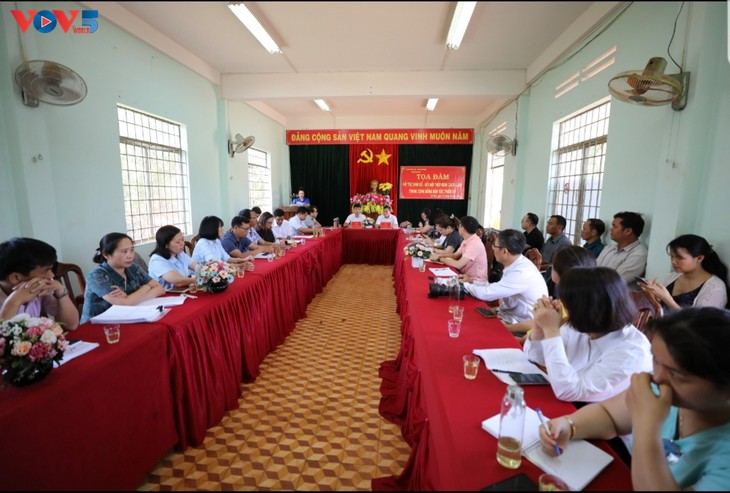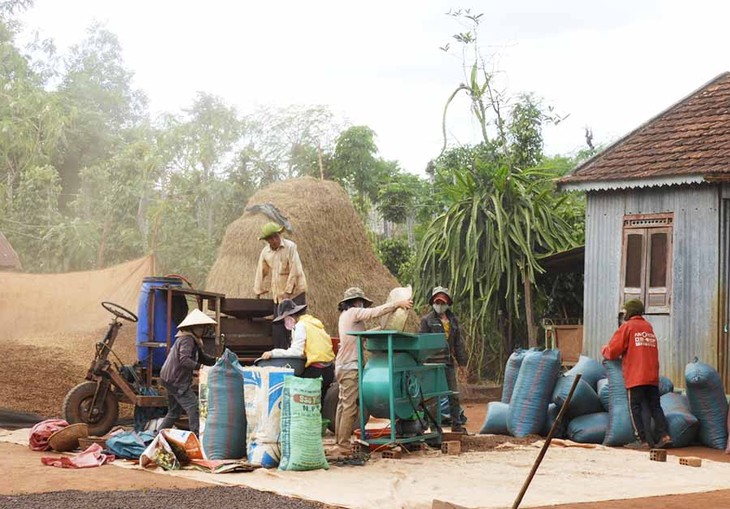(VOVWORLD) - 20 years ago, Ha Bau commune in Gia Lai province, was a center of illegal religious propagation and people lived in poverty. That has changed now. The security and political situation has stabilized and religious activities now abide by the law. Ha Bau commune has been recognized as a new-style rural village.
 A seminar on socio-economic development in Ha Bau commune (Photo: Ngoc Anh/VOV5) A seminar on socio-economic development in Ha Bau commune (Photo: Ngoc Anh/VOV5) |
Ha Bau is situated in the north of Dak Doa district and occupies a strategic position in the central highland province of Gia Lai. It comprises 8 hamlets with 7,800 people. One hamlet has a majority of Kinh people and the rest are ethnic minorities, mostly Jrai and Bana.
In the early 2000s, Ha Bau commune was one of the most politically unstable areas in Gia Lai and was considered the den of the Fulro anti-government group in the Central Highlands region.
Fulro persuaded locals to follow so-called “Dega Protestantism,” a religion not officially recognized in Vietnam. Fulro leaders living in exile abroad incited the ethnic people here to protest against the government and riot in an attempt to establish a so-called "Dega State" - an autonomous state comprised of Central Highland ethnic minority groups.
Nguyen Huu Tho, Secretary of the Dak Doa district Party Committee and Chairman of the district People's Council, said that the whole political system, especially the local administration, have helped misguided people make a fresh start and public order in Ha Bau commune has been restored.
“We realize that the local people were misguided because they were poorly informed, were incited by outsiders, and wanted to improve their difficult life. We must help them stabilize their lives, find jobs, reduce their backwardness, and re-integrate into the greater community. We use different ways to support and encourage them, depending on each person’s circumstances,” said Tho.
Educating and converting those who used to be Fulro members has been largely successful. Most now abide by State policies and laws and haven’t returned to committing offences.
Bome, a Bana ethnic man in Rai village and a former Fulro leader, said, “I feel regret. Our current living conditions are much better than in the past. There were no roads or schools. Now we have roads, bridges, and medical stations. The government has given all of us social security.”
There are four religions in Ha Bau commune - Buddhism, Catholicism, Protestantism, and Cao Dai.
Religious organizations and groups operate in accordance with the Ordinance on Beliefs and Religions and other State laws. Religious activities and programs are registered annually. Followers of all religions have united to help each other do business.
According to Y Mlui, a Jrai person living in Ha Bau commune, “The three ethnic groups - Kinh, Bana, and Jrai - in the commune are united to do business, develop the local economy, and promote the commune’s social order and safety. We welcome contributions by people who were misguided in the past but now have been converted.”
Ha Bau, an agricultural commune, has an area of nearly 4,800 ha, of which 3,800 ha are used for agricultural production and 130 ha for forestry. It has more than 14,000 heads of cattle and poultry. In the past 10 years, Ha Bau has invested more than 2 million USD in repairing and building infrastructure. Last year two vocational training classes were organized for rural workers.
Ha Bau has cooperated with the Vĩnh Hiệp Company to help households in hamlet 76 and Sao Dup hamlet establish a sustainable coffee production.
 Ha Bau villagers are busy harvesting (Photo: baogialai.com.vn) Ha Bau villagers are busy harvesting (Photo: baogialai.com.vn)
|
Y Hieu, Vice Chairman of Ha Bau People’s Committee, said, “The commune’s strength is coffee and pepper trees. Life here is improving day by day. The infrastructure meets basic development requirements, and the political situation is stable. Human rights are protected, and people have access to jobs, vocational training, and medical examination and treatment. Early last year, Ha Bau had 40 poor households, 2% of the total. By the end of last year, the number of poor households had fallen to 28, 1.5% of the total. The commune has worked to build a more modern lifestyle, eradicate social evils, and promote local cultural identities.”
Ha Bau has changed remarkably since being recognized as a new-style rural village. Its economy is based on agriculture, trade, services, and handicrafts. Per capita income last year was about 1,800 USD, quite high compared to other ethnic minority areas in the Central Highlands.
Jrai Ksor Krung of Ha Bau commune said, “In 2001, I crossed the border illegally into Cambodia and was imprisoned for 9 months. I’d like to say thanks to the State for letting me return to my hometown to do business to help my family. All I want now is to stay home, do some farming, raise cows, and grow coffee trees. I’ll no longer listen to malefactors who want me to leave Vietnam illegally. Now my family earns between 2,600 and 3,000 USD a year.”
Life in Ha Bau is improving. In particular, the movement to unite all people in building a good culture-centered life is proving beneficial. All eight hamlets in Ha Bau have earned the “Cultural Village” designation. The commune completed all the new-style rural building criteria last year, becoming the only locality in Dak Doa district to do so.